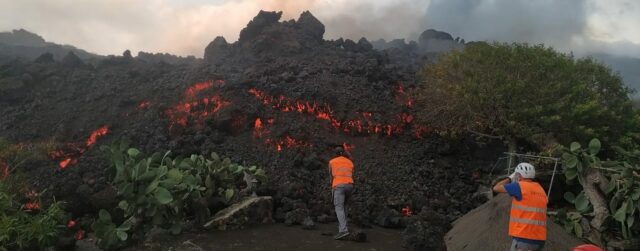Deep in the Earth’s mantle, branching columns of hot material are lifting magma to the surface. They are the mantle plumes, which allow us to anticipate where the oceans will open and what parts of the planet will be washed away in tens of millions of years.
The mantle feathers or mantle feathers are narrow columns of hot material from the Earth’s mantle; they are supposed to exist under the earth’s crust, producing magma, hot spots, and places with intense volcanism.
Until now, it had not been possible to see them directly. But new research developed between 2012 and 2013, the results of which have now been published in Nature Geoscience, has managed to produce an image of one of the most important mantle plumes to appear on the planet in the last 100 million years, the Quanta journal reports.
The authors of this research have built the seismic equivalent of a giant telescope and observed a considerable segment of the mantle using 57 submerged marine seismometers in an area of 2,000 square kilometers of the Western Indian Ocean.
They completed the data obtained with those recorded by 37 seismic stations located in Madagascar and other smaller islands, and captured a huge spot located under the island of Reunion, east of Madagascar.
African giant spot
It is one of the 2 huge giant blobs of material that had been discovered in the 1970s of the 20th century, one under Africa and the other under the Pacific; they are hot colossi that, between them, cover approximately 30% of the boundary between the mantle and core of the planet.
The spots are the length of a continent and their altitude is 100 times that of Mount Everest. They settle at the bottom of the rocky mantle of the Earth. Both spots are made of rock, just like the rest of the mantle, but they can be hotter and heavier -they hold the key to uncovering the history of Earth’s past.
Scientists also believe that these spots play a role in many of deep Earth processes, including plate tectonics and volcanism, as the new research seems to confirm.
Spotted plumes
Based on the findings of the new study, the researchers believe that all mantle plumes on Earth are rooted in patches of Africa or the Pacific. They have reached this conclusion because they were able to observe, at a depth of 2,900 kilometers, that the African stain grows from its center to form a trunk that goes up to 1,500 kilometers deep.
They also appreciated that, from the upper part of the African stain, various branches of hot matter grow diagonally that rise even further, up to 800 kilometers deep. Then even thinner hot branches emerge from them and rise vertically to form mantle plumes.
Intraplate volcanoes
One of those huge plumes reaches the bottom of the volcanic island of Reunion, which is believed to be home to other mantle plumes. The mantle plumes are around 200 °C warmer than the environmental mantle. When they reach the base of tectonic plates, their heat melts the surroundings, producing a large amount of magma, explains Quanta.
The feathers also carry mantle material from deep within the Earth into the crust. This material melts when it reaches the lower pressures far from the core, supplying additional magma to the crust.
The combined supply of hot magma accounts for a large number of Earth’s intraplate volcanoes, which are volcanoes that are created in the center of a tectonic plate. There are an estimated 50 hot spots on Earth, all located on top of a mantle plume. Hot spots are much more common under the oceanic crust because it is thinner -the plume can pass through it more easily.
Africa will be cracked

Continental hot spots are rarer, as a denser plume is required to break through the crust. Although eruptions from these hot spots are rare, they can become massive. Yellowstone is a prime example of a continental hotspot.
The researchers of the new study suggest that, if the feathers observed in the Indian Ocean sustain their ancestral dynamics, within tens of millions of years they will cause the disintegration of the African continent and the creation of a new micro-continent, emerged next to a new ocean.
The finding, in addition to being novel, is promising because it allows seismologists to have a window to the fiery future of the planet, highlights Quanta.
By looking at the boundary between the core and the mantle, perhaps one can even predict where the oceans will open up, the researchers say, adding that they can now forecast the part of the Earth that will one day be washed away by the planet’s geological dynamics.

